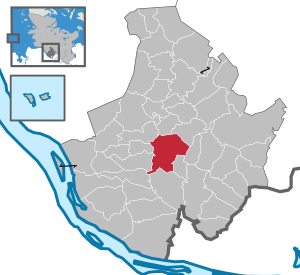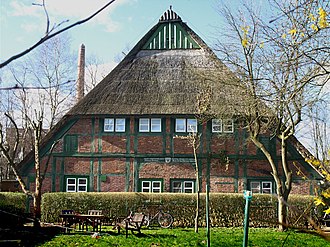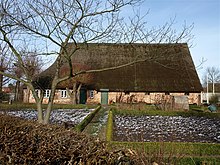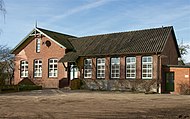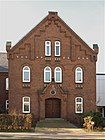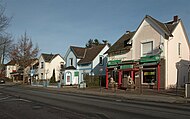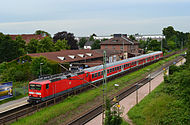Tornesch
| coat of arms | Germany map | |
|---|---|---|

|
Coordinates: 53 ° 42 ' N , 9 ° 43' E |
|
| Basic data | ||
| State : | Schleswig-Holstein | |
| Circle : | Pinneberg | |
| Height : | 13 m above sea level NHN | |
| Area : | 20.61 km 2 | |
| Residents: | 14,066 (Dec. 31, 2019) | |
| Population density : | 682 inhabitants per km 2 | |
| Postal code : | 25436 | |
| Primaries : | 04122, 04120 | |
| License plate : | PI | |
| Community key : | 01 0 56 048 | |
| LOCODE : | DE TNH | |
City administration address : |
Wittstocker Strasse 7 25436 Tornesch |
|
| Website : | ||
| Mayoress : | Sabine Kählert (independent) | |
| Location of the city of Tornesch in the Pinneberg district | ||
Tornesch ( Low German : Torneesch ) is a town in the Pinneberg district in Schleswig-Holstein . It borders directly on the city of Uetersen and the communities Heidgraben , Klein Nordende , Seeth-Ekholt , Ellerhoop , Kummerfeld , Prisdorf , Appen and Moorrege (clockwise).
geography
Tornesch located 16 kilometers northwest of Hamburg at the edge of the marsh areas on the protruding into the march Geest . It is bordered to the south by the Pinnau and the Bilsbek , to the west by the Ohrtbrookgraben and to the east by the former federal highway and the Autobahn 23.
The districts of Ahrenlohe, Esingen and Oha belong to Tornesch.
history
History of Esingen
The village of Esingen is the oldest part of the city of Tornesch. It is a primeval village and belongs to a group of villages, the origin of which experts trace back to the 6th and 7th centuries AD. It has been documented since 1285, when Heinrich II von Barmstede gave the Uetersen Monastery, founded in 1235, additional income and rights .
History of Ahrenlohe
Ahrenlohe is mentioned in the second half of the 17th century. Initially, a few cottages serve as residence for workers in the moor and forest area. At the beginning of the 18th century, farms and other buildings followed.
History of Tornesch
Tornesch owes its foundation to the construction of the railway line between Altona and Kiel ( Altona-Kieler Eisenbahn-Gesellschaft ). This was initiated by the Danish King Christian VIII . The villages of Uetersen (here in particular the local haulage contractors) and Esingen (with the district of Ahrenlohe) and their citizens spoke out against the construction of a railway, but could not prevent the construction. But they could refuse to build their own train station.
The farmer Jürgen Siemsen took advantage of this. He left the king the reason to build a train station. In return, he was given the right to be licensed in the station inn. This is considered to be the birth of the new district: Tornesch . A cinema was located here for years and the municipal council meetings took place in the rooms, in which the renaming of the place (see below) was decided.
After the construction of the railway and the train station, factories settled there and attracted large numbers of workers. These settled in the district of Tornesch, which began to develop. Soon Tornesch was bigger than Esingen and, above all, better known because the factories and shops used Tornesch as the address instead of Esingen. Initiated by the landowners association, the municipal council decided in 1930 to name the municipality of Tornesch and no longer Esingen . Ahrenlohe and Esingen received the status of districts. During the Third Reich, the distillery produced important additives for aviation fuel , among other things , to increase the knock resistance , and it is surprising that Tornesch was not more frequently the target of bombing. After all, there were only five producers and the distillery was one of the best performing. This happened after the expropriation of the previous Jewish owners.
The excavation in the area of the Tornescher Hof (1st phase) was taken to the Ecklak hazardous waste landfill in the Steinburg district after construction was stopped . In the area of the second construction phase, groundwater renovations took place over the years. Today there is only a rudiment of the old laboratory in parts, which housed the office of Stadtwerke Tornesch (SWT) and other traders, as well as an Italian restaurant at times. The formative parts of the former distillery were torn down for the settlement of shopping opportunities and the redesign of the town center.
The city charter was granted on 1 January 2005 Tornesch. The conditions for the award were given years earlier, but the application was only made after the change in local laws. Today no significant privileges are associated with the town charter, but the mayor and some Tornescher local politicians hoped for a higher, supraregional reputation of the municipality and thus new impulses for investors.
politics
Council meeting
Result of the local elections on May 6, 2018
| Political party | be right | percent | Seats |
|---|---|---|---|
| CDU | 2569 | 41.9% | 12 |
| SPD | 1633 | 26.6% | 7th |
| GREEN | 1297 | 21.2% | 6th |
| FDP | 633 | 10.3% | 3 |
| Turnout: 52.8% | |||
Sabine Kählert (non-party) was elected mayor in May 2018.
coat of arms
The coat of arms was approved on September 3, 1965.
Blazon : "In blue a free-standing golden pinnacle tower made of bricks with an open gate, accompanied by a golden ash leaf on each side."
Tornesch is understood in folk etymological interpretation of the name as a combination of the words tower and ash. The low German language form of the building is "Torn". The scientific explanation of the place name is based on several, figuratively unappealing interpretations. Both parts of the name are taken into account in the coat of arms by a corresponding figure. The ash leaf, which represents the tree as “pars pro toto”, is shown twice for reasons of symmetry. Since the coat of arms does not contain other figures, it is the perfect example of a "talking" heraldic symbol. It just shows what the name says: the tower and the ash. Until 1930, the place, made up of the village of Esingen and the Tornesch residential area on the Kiel-Altona railway line, was called Esingen.
The coat of arms was designed by the Brunsbüttel heraldist Willy "Horsa" Lippert .
flag
The flag was approved on December 6, 1991.
The figures of the municipal coat of arms in flag-appropriate tinging are on blue flag cloth.
Town twinning
Tornesch has town partnerships with:
A partnership with the Danish municipality of Jammerbugt was concluded in 2008.
Culture and sights
building
In the older districts of Ahrenlohe and Esingen, there are rural residential buildings from the early modern period as well as buildings from the beginning of the 20th century:
- Ostermannscher Hof from 1738 (today the Tornescher Heimathaus; under monument protection)
- Esinger primary school “Johannes-Schwennesen-Schule”, inaugurated in 1906
- Former primary school in Ahrenlohe (built in 1882), club room and the seat of the Ahrenlohe volunteer fire brigade in the annex . Cultural center since 2018.
In the vicinity of the train station , the old parter's house of the former Tornescher Hof from 1810 stood until 2013 (see history). There are also numerous buildings from the Wilhelminian era (up to the First World War):
- Station building from 1844: It has been heavily modified to this day and is a listed building, although only the location reminds of its old function. The baggage acceptance area has been converted into a newsagents. The old train station restaurant was once built with a shoe shop (Schuh Fleck), then with a video library and now houses a bar-like restaurant. Today the addiction counseling center is located in the upper area. The Tornesch water company and a hairdresser were housed there for a few years. For some time the previous owner (Radio Dörr) had his sales rooms in the lower rooms. In the almost original goods reception, which was built later, there is still an operating room of the DB, as well as the Eisenross bicycle shop.
- The rest of the old distillery (laboratory part), built in 1914/1915, has been converted into a restaurant and commercial building
- Old post office on Esinger Strasse
- Villas from the beginning of the 20th century
- The Tornescher Church was built in 1960. In addition, there are numerous smaller residential buildings from the beginning of the 20th century in the center of the village, as are often found in the outskirts of Hamburg. They are mostly asymmetrical plastered buildings. One half is gable constantly , the other traufständig . Dr. Klaus Mühlfried called this type a side elevation house.
Tornescher Kirche Jürgen-Siemsen-Str., Built in 1960
Culture
The most famous clubs are the mixed choir Esinger Liedertafel from 1876 , the oldest club in Tornesch and the gymnastics and games club TuS Esingen . Tornesch also has an animal welfare association. This also has a dog group and an asylum kennel. The Tierschutzverein Tornesch e. V. works closely with the animal shelter in Elmshorn.
The town's annual celebrations include the Easter bonfire organized by the volunteer fire brigades , the biennial wine festival of the cultural community and the Christmas market that takes place around the “Pomm 91” day care center for the elderly, where many clubs and parties are present.
Probably the most active cultural institution in the city is the Tornesch cultural community. Since it was founded in 1985 on the occasion of the 700th anniversary of the ancient village Esingen, it has become an institution. Together with members of the Esinger Liedertafel, she created the home of the residents of her city. The Heimathaus is the only registered monument in the city of Tornesch and is very well received by the population.
Religions
The largest parish is the Evangelical Lutheran parish on Jürgen-Siemsen-Strasse. In addition to the church center next to the church, which has a children's playroom, the community also operates the Bonhoefferhaus in Esinger Moor on Wachsbleicher Weg.
The hotly debated weathercock on the church roof in the 1960s was built by the plumber Huckfeld. The origin of a separate church building in Tornesch was the church hall in the Esinger school. In 2006 it was almost restored to its original state.
The New Apostolic church congregation merged with the Uetersen congregation in October 2008. The common meeting place is now in Uetersen.
There is a new building for Jehovah's Witnesses at the fork between Koppeldamm and Pastorendamm. Until 2005, parts of the adult education center were housed in their former building on Norderstrasse.
museum
Tornesch has had a museum since May 2007. The Folklore Museum Mölln Hof shows a folklore collection in the former farm building of the Mölln-Hof in Tornesch-Esingen from May to October (1st Sunday of the month 1pm - 5pm) on approx. 800 m².
Events
ToAll (Tornescher Allerlei) has been trying to revive the cultural scene in Tornesch since 1991. The events usually take place in the “Pomm 91” day care center for the elderly. Another recurring event is the annual Christmas market organized by the working group of independent welfare associations.
economy
Several industrial companies are located in Tornesch. The Tornesch-based company Papierfabrik Meldorf emerged from the Altonaer Wellpappenfabrik and the Meldorfer Papierfabrik . It was formerly part of Panther Packaging . In 2017 it was sold to Certina Holding .
Other important companies are the Hanseatisches Wein- und Sektkontor ( Hawesko Holding AG ) and HellermannTyton , which are involved in the fastening and marking of cables. Tornesch is also traditionally a tree nursery area.
At the station, on the site of the former distillery, several chains have settled (KIK, Aldi, Rossmann, TEDI), as well as a pharmacy, a bakery, hairdresser, tanning salon and an EDEKA market.
The unemployment rate is around 5.3 percent.
traffic
Junction 15 of the A 23 motorway from Hamburg to Heide (Holstein) is located in Tornesch .
Tornesch has had a station in the Hamburg-Altona - Elmshorn section of the Hamburg-Altona-Kiel railway line since September 18, 1844 . a. is served by the regional train lines RB61 and RB71 and is part of the Hamburger Verkehrsverbund . At the station, the single-track line of the Uetersen railway branches off to the neighboring Uetersen , whose passenger traffic was discontinued in 1965. This was replaced by buses , some of which also drive over Heidgraben . The bus traffic was taken over by the newly formed traffic company Kreisverkehrsgesellschaft in Pinneberg (KViP), which is now u. a. Bus lines from Tornesch to Uetersen (both directly and via Heidgraben) and to Ellerhoop operate, now also within the HVV.
In 2009, a pedestrian bridge without a roof was decided to improve the connection to Hamburger Straße , which could be financed through the urban development measures. Due to vandalism and bad planning, the maintenance costs have risen significantly.
Tornesch is directly connected to the Hanseatic city of Hamburg and the district town of Pinneberg . In addition, the connection to the A 23 offers a good infrastructure, which is attracting more and more private individuals and companies to the city. See also: suburbanization .
The Ahrenlohe airfield is located in the district of Tornesch .
Education
In the city of Tornesch there are the Klaus-Groth-Schule (community school with upper level), the Fritz-Reuter-Schule (elementary school) and the Johannes-Schwennesen-Schule, the primary school Esingen. The Wilhelm-Busch-Schule support center was dissolved at the end of the 2009/2010 school year. The special educational support in Tornesch is provided by the Geschwister-Scholl-Schule in Uetersen. The Realschule Tornesch and the secondary school branch of the Fritz Reuter School expired in July 2007. The responsible schools are therefore the elementary and regional school Rosenstadtschule and the Ludwig-Meyn-Gymnasium , both located in Uetersen. The Tornesch city library is now located in the building of the Klaus Groth School. There is also a joint adult education center with Uetersen, which is based in Tornescher Hof.
literature
- Annette Schlapkohl, Ernst Martin Groth Foundation (ed.): Tornesch. The history of the districts of Ahrenlohe, Esingen and Tornesch from the beginning until today . Husum 2004.
Web links
Individual evidence
- ↑ North Statistics Office - Population of the municipalities in Schleswig-Holstein 4th quarter 2019 (XLSX file) (update based on the 2011 census) ( help on this ).
- ↑ a b Schleswig-Holstein topography. Vol. 10: Timmaspe - Ziethen . 1st edition Flying-Kiwi-Verl. Junge, Flensburg 2008, ISBN 978-3-926055-92-7 , p. 28 ( dnb.de [accessed on August 6, 2020]).
- ↑ Changes in the municipalities in Germany, see 2005. StBA
- ↑ Sabine Kählert is mayor - source: https://www.shz.de/19943001 © 2019. Retrieved July 18, 2019 .
- ↑ a b Schleswig-Holstein's municipal coat of arms
- ↑ Monument Ostermannscher Hof ( Memento of the original from March 13, 2014 in the Internet Archive ) Info: The archive link was automatically inserted and not yet checked. Please check the original and archive link according to the instructions and then remove this notice. ; accessed: April 10, 2013.
- ↑ Klaus Mühlfried: On the threshold to modernity. Booklet accompanying the exhibition of the same name on Tornesch residential buildings, Tornesch 2007.
- ↑ Pinneberger Tageblatt of February 6, 2013 and Uetersener Nachrichten of February 8, 2013

